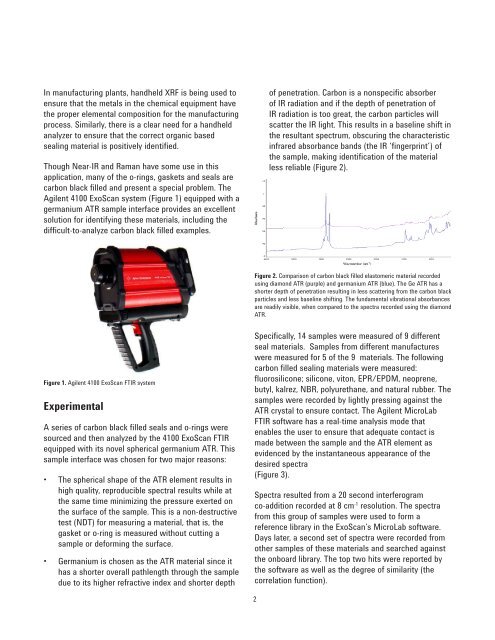Application Compendium - Agilent Technologies
Application Compendium - Agilent Technologies
Application Compendium - Agilent Technologies
You also want an ePaper? Increase the reach of your titles
YUMPU automatically turns print PDFs into web optimized ePapers that Google loves.
In manufacturing plants, handheld XRF is being used to<br />
ensure that the metals in the chemical equipment have<br />
the proper elemental composition for the manufacturing<br />
process. Similarly, there is a clear need for a handheld<br />
analyzer to ensure that the correct organic based<br />
sealing material is positively identified.<br />
Though Near-IR and Raman have some use in this<br />
application, many of the o-rings, gaskets and seals are<br />
carbon black filled and present a special problem. The<br />
<strong>Agilent</strong> 4100 ExoScan system (Figure 1) equipped with a<br />
germanium ATR sample interface provides an excellent<br />
solution for identifying these materials, including the<br />
difficult-to-analyze carbon black filled examples.<br />
Figure 1. <strong>Agilent</strong> 4100 ExoScan FTIR system<br />
Experimental<br />
A series of carbon black filled seals and o-rings were<br />
sourced and then analyzed by the 4100 ExoScan FTIR<br />
equipped with its novel spherical germanium ATR. This<br />
sample interface was chosen for two major reasons:<br />
• The spherical shape of the ATR element results in<br />
high quality, reproducible spectral results while at<br />
the same time minimizing the pressure exerted on<br />
the surface of the sample. This is a non-destructive<br />
test (NDT) for measuring a material, that is, the<br />
gasket or o-ring is measured without cutting a<br />
sample or deforming the surface.<br />
• Germanium is chosen as the ATR material since it<br />
has a shorter overall pathlength through the sample<br />
due to its higher refractive index and shorter depth<br />
2<br />
of penetration. Carbon is a nonspecific absorber<br />
of IR radiation and if the depth of penetration of<br />
IR radiation is too great, the carbon particles will<br />
scatter the IR light. This results in a baseline shift in<br />
the resultant spectrum, obscuring the characteristic<br />
infrared absorbance bands (the IR ‘fingerprint’) of<br />
the sample, making identification of the material<br />
less reliable (Figure 2).<br />
Figure 2. Comparison of carbon black filled elastomeric material recorded<br />
using diamond ATR (purple) and germanium ATR (blue). The Ge ATR has a<br />
shorter depth of penetration resulting in less scattering from the carbon black<br />
particles and less baseline shifting. The fundamental vibrational absorbances<br />
are readily visible, when compared to the spectra recorded using the diamond<br />
ATR.<br />
Specifically, 14 samples were measured of 9 different<br />
seal materials. Samples from different manufactures<br />
were measured for 5 of the 9 materials. The following<br />
carbon filled sealing materials were measured:<br />
fluorosilicone; silicone, viton, EPR/EPDM, neoprene,<br />
butyl, kalrez, NBR, polyurethane, and natural rubber. The<br />
samples were recorded by lightly pressing against the<br />
ATR crystal to ensure contact. The <strong>Agilent</strong> MicroLab<br />
FTIR software has a real-time analysis mode that<br />
enables the user to ensure that adequate contact is<br />
made between the sample and the ATR element as<br />
evidenced by the instantaneous appearance of the<br />
desired spectra<br />
(Figure 3).<br />
Spectra resulted from a 20 second interferogram<br />
co-addition recorded at 8 cm -1 resolution. The spectra<br />
from this group of samples were used to form a<br />
reference library in the ExoScan’s MicroLab software.<br />
Days later, a second set of spectra were recorded from<br />
other samples of these materials and searched against<br />
the onboard library. The top two hits were reported by<br />
the software as well as the degree of similarity (the<br />
correlation function).

















